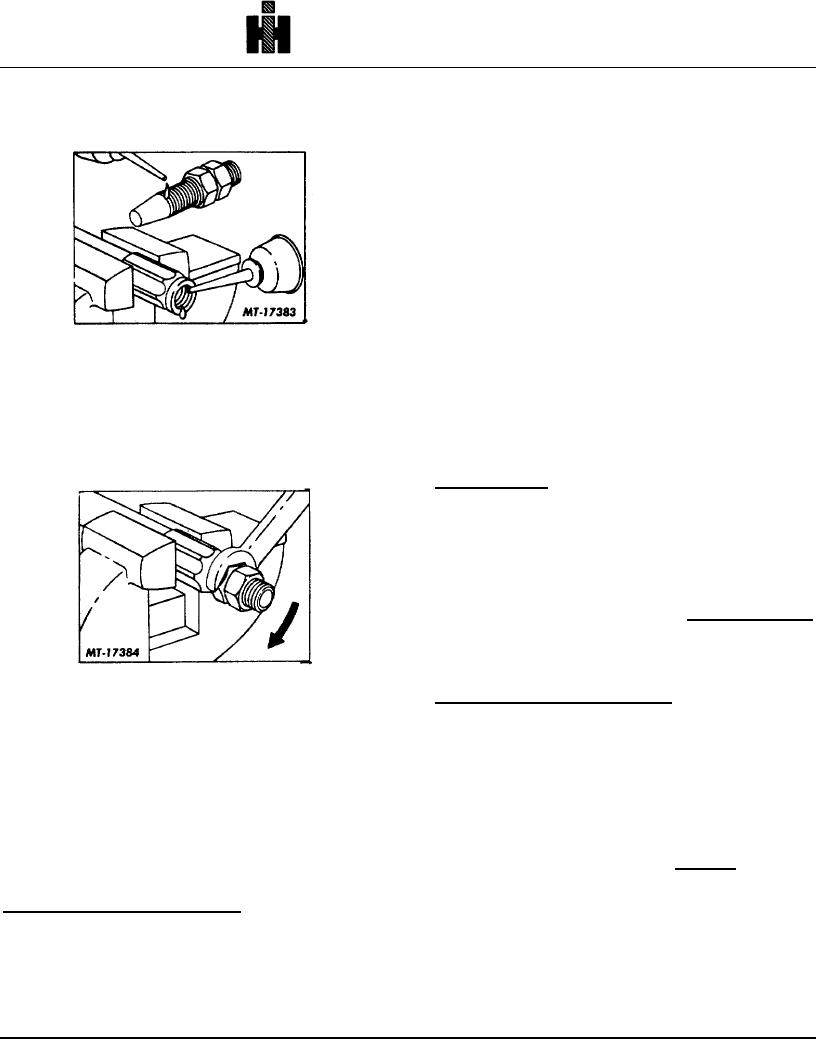
TRUCK SERVICE MANUAL
BRAKES-AIR
7. Reposition hose and socket in the vise as shown
1. High external temperatures will shorten the life of
in Fig. 4. Lubricate hose socket and fitting
a hose. Route hoses away from hot manifolds
threads.
and exhaust systems.
2. Abrasion of hoses will cause outer surfaces to
wear and weaken the hose. When installing
these flexible hoses avoid contact or
crisscrossing, sharp surfaces and contact of
moving parts (shift levers and pedals). Clip
hoses in place to prevent vibration, abrasion;
route hoses together and parallel. If the hose
cannot be clipped adequately, the hose must be
equipped with a protective conduit (cover). If the
hose being replaced has a protective conduit, be
sure to use a cover on new hose.
Fig. 4
3. Flexing of short hoses should not be allowed,
8. Position hose socket in swivel nut and
since this will tend to wear the hoses at the
fittings. If the hose must move, do not permit the
reassemble pipe adapter (if removed) to lock
hose to twist; keep the bend in the hose in the
swivel nut on the fitting. Thread the fitting and
same plane as the movement where the hose is
swivel nut (with pipe adapter) assembly into the
connected. Provide enough hose to permit any
hose as shown in Fig. 5 leaving 1/32" to 1/16"
movement which may be required. Avoid sharp
clearance between nut and socket so that the
bends or turns in the hoses.
nut can swivel freely.
NYLON TUBING
In past years nylon tubing of varying construction has
been used in such diverse applications as rear axle shift
control lines, windshield wiper motor supply lines,
transmission shift control lines and engine governor
control lines.
With production of nylon tubing as a replacement for
certain copper tubing in chassis air brake system
applications, a superior nylon tubing which is suitable for
all of the above applications as well as air brake system
applications is now being provided for field service use.
Fig. 5
Nylon Tubing Assembly Instructions
For the most part nylon tubing in air brake systems is
9. Repeat steps 5, 6, 7 and 8 on opposite end of
assembled much like copper tubing. The same fittings,
hose to install the remaining nut and fitting.
sleeves and nuts used with copper tubing can be used
with nylon tubing. Long or short tube nuts may be found
10. Lubricate the threads of the hose assembly
on chassis in service with nylon tubing (Figs. 6 and 7).
when connecting the lines (use light engine oil
Either nut may be satisfactorily used on the nylon lines.
sparingly).
NOTE:
If copper tubing is being
11. When installing the new hose assembly on the
substituted for nylon tubing, the short
vehicle be sure to check for possible leakage
tube nut shown in Fig. 7 must not be
and correct any leaks if leaks are present.
used. Either the short tube nut or the
long tube nut may be used satisfactorily
Hose Assembly Special Instructions
with nylon tubing.
Installation and routing of these hoses is just as
A tube support or insert will be used in all
important as special attention given to the installation of
applications of the nylon tubing in air brake systems.
the ends.
Common problems encountered with
The insert provides a stiff or rigid area for the sleeve to
installation and routing which will result in short service
be crimped or compressed
life of these hoses are:
166

